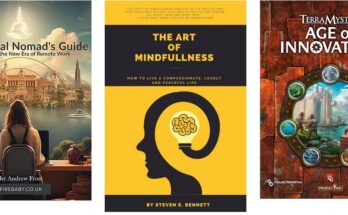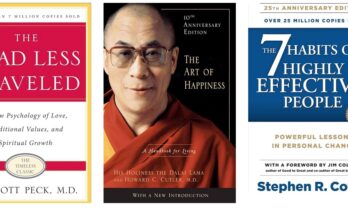


The Power of Habit" by Charles Duhigg vs The Art of Happiness" by Dalai Lama XIV and Howard Cutler vs The War of Art" by Steven Pressfield
Comparing “The Power of Habit” by Charles Duhigg, “The Art of Happiness” by the Dalai Lama XIV and Howard Cutler, and “The War of Art” by Steven Pressfield reveals distinct perspectives on personal development and growth. Here’s an overview of each book, followed by a detailed comparison in a table format.
The Power of Habit by Charles Duhigg
Overview: Charles Duhigg’s “The Power of Habit” explores the science behind why habits exist and how they can be changed. Duhigg presents a framework for understanding habits through the habit loop: cue, routine, and reward. He illustrates his points with compelling stories and case studies, showing how habits impact individuals, organizations, and societies.
Key Concepts:
- Habit Loop: The neurological loop at the core of every habit.
- Keystone Habits: Certain habits that can trigger widespread change.
- Changing Habits: Techniques and strategies for altering habits.
Structure: The book is divided into three parts:
- The Habits of Individuals
- The Habits of Successful Organizations
- The Habits of Societies
The Art of Happiness by Dalai Lama XIV and Howard Cutler
Overview: “The Art of Happiness” combines the spiritual wisdom of the Dalai Lama with the psychological insights of Howard Cutler to provide a guide to living a happier life. It emphasizes the importance of inner development and the cultivation of compassion, kindness, and mental discipline.
Key Concepts:
- Happiness as a State of Mind: The perspective that happiness comes from within.
- Compassion and Connection: The role of compassion in achieving happiness.
- Mental Training: Techniques for training the mind to cultivate positive states.
Structure: The book is organized around interviews and discussions between the Dalai Lama and Howard Cutler, interwoven with practical advice and exercises.
The War of Art by Steven Pressfield
Overview: Steven Pressfield’s “The War of Art” addresses the internal obstacles that prevent individuals from achieving their creative potential. The book is a call to arms for artists, writers, and anyone looking to overcome resistance and fulfill their creative ambitions.
Key Concepts:
- Resistance: The invisible force that hinders creative efforts.
- Turning Pro: The mindset shift required to overcome resistance.
- The Muse: Embracing the idea of inspiration and the divine in the creative process.
Structure: The book is divided into three parts:
- Resistance: Defining the Enemy
- Combating Resistance: Turning Pro
- Beyond Resistance: The Higher Realm
Comparative Analysis
Themes
| Aspect | The Power of Habit | The Art of Happiness | The War of Art |
|---|---|---|---|
| Core Theme | Understanding and changing habits | Achieving happiness through inner peace | Overcoming creative resistance |
| Primary Focus | Habits and their impact on life | Mental well-being and happiness | Creative productivity and resistance |
| Approach | Scientific and empirical | Spiritual and psychological | Motivational and practical |
Structure
| Aspect | The Power of Habit | The Art of Happiness | The War of Art |
|---|---|---|---|
| Format | Case studies and scientific explanation | Conversations and practical advice | Short, motivational chapters |
| Organization | Three parts: Individuals, Organizations, Societies | Interviews and thematic discussions | Three parts: Resistance, Turning Pro, Beyond Resistance |
| Style | Informative and engaging | Reflective and insightful | Direct and inspirational |
Key Concepts
| Aspect | The Power of Habit | The Art of Happiness | The War of Art |
|---|---|---|---|
| Main Idea | Habits can be understood and changed | Happiness is cultivated internally | Resistance is the main enemy of creativity |
| Important Principles | Habit loop, keystone habits | Compassion, mental discipline | Turning pro, embracing the muse |
| Practical Applications | Techniques for changing habits | Exercises for mental training | Strategies to overcome resistance |
Audience
| Aspect | The Power of Habit | The Art of Happiness | The War of Art |
|---|---|---|---|
| Target Audience | General readers interested in self-improvement | Individuals seeking happiness and peace | Creative individuals facing resistance |
| Usefulness | Broad applicability in personal and professional life | Practical advice for everyday happiness | Specific focus on creative pursuits |
Impact and Reception
| Aspect | The Power of Habit | The Art of Happiness | The War of Art |
|---|---|---|---|
| Critical Reception | Widely praised for its accessible science | Acclaimed for its wisdom and insight | Highly regarded in creative communities |
| Influence | Significant influence on personal development literature | Impactful in both spiritual and psychological fields | Inspired many creatives to pursue their work |
Personal Development Focus
| Aspect | The Power of Habit | The Art of Happiness | The War of Art |
|---|---|---|---|
| Self-Improvement | Understanding and altering habits | Cultivating inner happiness | Overcoming internal barriers |
| Behavioral Change | Practical strategies for habit change | Mental training techniques | Motivational strategies |
| Mindset Shift | Awareness of habit patterns | Focus on compassion and kindness | Adopting a professional attitude |
Conclusion
Each book offers unique insights into personal development:
- “The Power of Habit” provides a scientific framework for understanding and changing habits, making it valuable for anyone looking to improve their behavior and routines.
- “The Art of Happiness” blends spiritual wisdom with psychological insights, offering a profound guide to achieving happiness through inner peace and mental training.
- “The War of Art” delivers a motivational call to arms for creatives, emphasizing the need to overcome resistance and adopt a professional mindset to achieve artistic success.
By understanding the different approaches and insights of these books, readers can choose the one that best suits their personal development needs and goals.




Fantastic post but I was wanting to know if you could write a litte more on this topic?
I’d be very grateful if you could elaborate a little
bit more. Thanks!
Wonderful website. Plenty of helpful information here.
I’m sending it to several pals ans additionally sharing in delicious.
And obviously, thanks to your sweat!